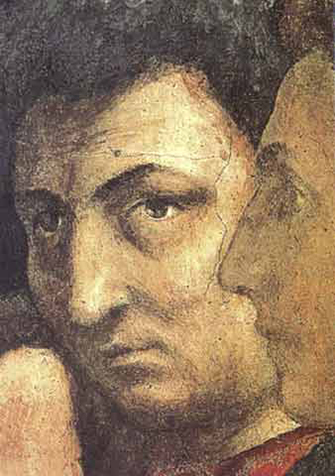The self portrait of the artist belongs to a grander painting titled Raising of the Son of Teophilus and St Peter Enthroned.
The painting in which the self-portrait of Masaccio is illustrated within is an incredibly large horizontal artwork that carries two focal points. The portrait of Masaccio is of a character lost in the presence of a large crowed.
It is incredibly interesting to witness the artist depicting himself within one of his artworks. This is the only painting of Masaccio in which the artist had decided to showcase himself. The grand painting showcases roughly twenties bodies, with the self portrait being one of them. While the artwork carries a great array of detail in regards to the actions and drama occurring around it, not a great deal of attention is paid to individual characters.
Yet, Masaccio carefully depicted his being with multitude of detail. While the texture of the canvas may seem to be rough, the surface of the piece has worn down through many years. The artist used a nude colour scheme to showcase the colour of his face in exact detail. The artist uses shades lighter and darker than the ones he uses for his skin tone, in order to highlight and contour his face. A more peachy orange is used to show depth beneath his eyes and around his temples.
The artist then transitions to a grey colour in which he uses shade areas of his face away from the light source. This grey colour adds a dead colour to the painting as if takes away from the natural light within the painting. By gently mixing the painting with a shade of white, Masaccio lightly touches upon different areas of his face to highlight different features. The right side of the tip of his nose is lightened, alongside his upper temple and check bone.
Masaccio was brilliant in placing an artificial light source within a specific area of his painting, and continuing it exactly throughout the piece.
Based on the characteristics of the self-portrait, it seems evident that Masaccio himself had small lips in comparison to the rest of the features on his face. His prominent nose aligns his face as it adds character to her face while displaying classic Roman features. The artist lightly depicts high eyebrows as they beautifully arch and frame his face.
His olive skin tone and dark features showcase his Roman ancestry, allowing his presence to easily join with the other figures in the artwork. It is interesting to note that while the artist showcased the artwork in an immense amount of detail, he focused on his self portrait in even more percussion. The viewer is able to witness the figure to Masaccio's right of a side profile of a man whose facial features do not carry as much element as Masaccio's do.
Yet, while an impeccable amount of detail was used to showcase MasaccioÕs self portrait, the artist still displayed his right eye through a deformed aspect. Perhaps based on the age of the artwork, or the lack of time the artist had, the eye is not displayed with as much percussion as the rest of the artwork is.
The captivating allure of artist, Masaccio, is based on his impeccable ability to showcase colour and detail through any piece of his work. The artist up rose to work within the Quattrocento art period during the 15th century in Italy.
Masaccio has been coined as the artist of his generation as he was able to capture life and movement within his work. The artist had highly influenced the style of art during the Renaissance Era, as other artists followed in his footsteps.




